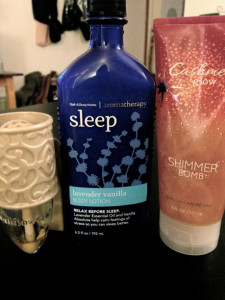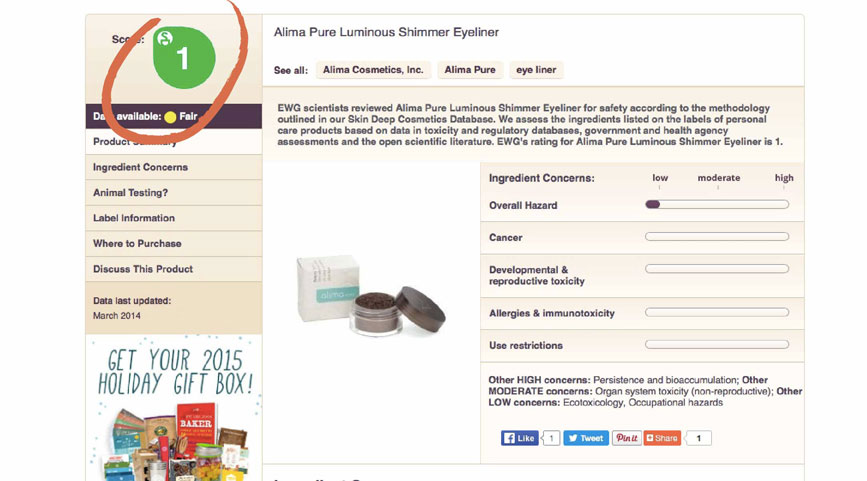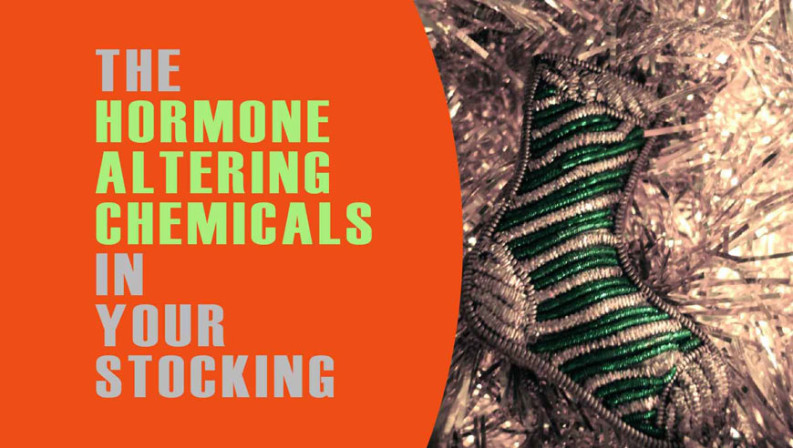 To find a thoughtful AND healthful gift, it’s my biggest dilemma of the season. This is even more true when it comes to stocking stuffers. When you look at the ingredients closely, the typical stocking stuffers—sweet treats, bath and beauty basics—are nothing but pure JUNK.
To find a thoughtful AND healthful gift, it’s my biggest dilemma of the season. This is even more true when it comes to stocking stuffers. When you look at the ingredients closely, the typical stocking stuffers—sweet treats, bath and beauty basics—are nothing but pure JUNK.
Here are some typical things that you may receive or put in stockings—lotions, nail polishes, lip balms, air fresheners, candles, soap, and everything else that is scented. They are fairly inexpensive, easy to find, fun, and festive.
I’m going to use the lavender body lotion in the picture as an example. The lotion contains propylparaben (endocrine disruptor), diazolidinyl urea (a formaldehyde releaser which may cause contact dermatitis), fragrance (which means a mixture of undisclosed chemicals), and a whole load of other ingredients that are associated with allergies and contact dermatitis—coumarin, citronellol, hydroxycitronella, benzyl alcohol, benzyl salicylate, cinnamal alcohol, geaniol, farnesol, limonene, and linalool.
So…What’s Wrong With Scented Products?
Well, nothing really, IF they are ONLY scented with pure essential oils and isolates derived from botanicals.
Otherwise…
- A study looked at 25 common and best selling household scented products and found over 100 chemicals, including some that are classified as toxic or hazardous by federal laws, and each product emitted 1-8 of these compounds. (1)
- The “green”, “natural”, or ”organic” products released as many hazardous chemicals as standard ones. (1,2)
- S. regulations do not require disclosure of all ingredients in a consumer product. (1)
- By law, manufacturers also don’t need to tell us any ingredient they use to make “fragrance”, because those are their “secret recipes”. (1) A single fragrance in a product maybe a mixture of hundreds of chemicals. (2)
- Lotion users are found to have higher butyl-paraben in their urine. (3) Parabens can cause endocrine disruption.
- Perfume users are found to have higher monoethyl phthalate in their urine. (3) Phthalates can cause endocrine disruption, developmental and reproductive toxicity.
- These studies show that the chemicals in our personal care products do get in our blood stream.
What To Do
- Go unscented.
The main human exposure to fragrances is through frequent use of scented products. (4)
- If you MUST have something scented, go with ones that are ONLY scented with pure essential oils and isolates derived from botanicals.
For example, check out candles and odor sprays at Way Out Wax.
- Skip nail polish, if pregnant.
A new study (5) shows that nail polish is a significant source of a suspected endocrine disruptor called triphenyl phosphate (TPHP).
- Less is more—use less hair spray, hair gel, hair mousse, nail polish, perfumes, scented deodorant, scented hand and body lotion
The average American woman uses 12 personal care products per day. One of every 24 women are exposed daily to personal care product ingredients that are known or probable reproductive and developmental toxins, linked to impaired fertility or developmental harm for a baby in the womb or a child. These statistics do not account for exposures to phthalates that testing shows appear in an estimated three quarters of all personal care products but that, as components of fragrance, are not listed on product ingredient labels. (6)
-
Check product safety on ewg.org/skindeep
EWG’s Skin Deep is an online database that contains information and safety assessment for 64,145 products of 2,244 brands. You can search by product, ingredient, or company. It will give you a hazard score and a data availability score. The safest products = low hazard score + fair or better data availability.

References:
- http://www.sciencedirect.com/science/article/pii/S0195925510001125
- http://www.ncbi.nlm.nih.gov/pmc/articles/PMC3018511/#b1-ehp.119-a16
- http://www.ncbi.nlm.nih.gov/pmc/articles/PMC4016195/
- http://www.ncbi.nlm.nih.gov/pmc/articles/PMC2790179/
- http://www.ncbi.nlm.nih.gov/pubmed/26485058
- http://www.ewg.org/research/not-too-pretty
About the Author
Dr. Lily Semrow is a Board Certified Chiropractic Neurologist who focuses on Neuro-Structural Correction. She has a B.S. in Nutrition and a doctorate in Chiropractic. She has a passion for serving families, and helping people who could not get better through traditional and alternative means.


Comments 2
Oh em gee… (really proper I know). I love these articles, very informative! Why is everything so bad for us? Dr. Lily has the answers 🙂 Thanks for linking those resources!
Author
Thanks for the feedback Marissa! I’m glad you liked it!